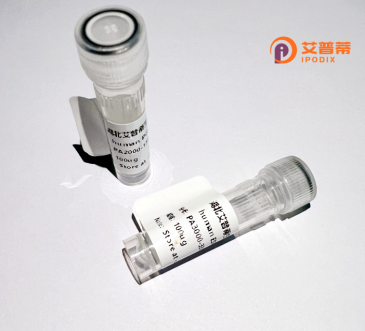
| 纯度 | >90%SDS-PAGE. |
| 种属 | Human |
| 靶点 | CDS2 |
| Uniprot No | O95674 |
| 内毒素 | < 0.01EU/μg |
| 表达宿主 | E.coli |
| 表达区间 | 1-445aa |
| 氨基酸序列 | MTELRQRVAHEPVAPPEDKESESEAKVDGETASDSESRAESAPLPVSADDTPEVLNRALSNLSSRWKNWWVRGILTLAMIAFFFIIIYLGPMVLMIIVMCVQIKCFHEIITIGYNVYHSYDLPWFRTLSWYFLLCVNYFFYGETVTDYFFTLVQREEPLRILSKYHRFISFTLYLIGFCMFVLSLVKKHYRLQFYMFGWTHVTLLIVVTQSHLVIHNLFEGMIWFIVPISCVICNDIMAYMFGFFFGRTPLIKLSPKKTWEGFIGGFFATVVFGLLLSYVMSGYRCFVCPVEYNNDTNSFTVDCEPSDLFRLQEYNIPGVIQSVIGWKTVRMYPFQIHSIALSTFASLIGPFGGFFASGFKRAFKIKDFANTIPGHGGIMDRFDCQYLMATFVNVYIASFIRGPNPSKLIQQFLTLRPDQQLHIFNTLRSHLIDKGMLTSTTEDE |
| 分子量 | 77.8 kDa |
| 蛋白标签 | GST-tag at N-terminal |
| 缓冲液 | 0 |
| 稳定性 & 储存条件 | Lyophilized protein should be stored at ≤ -20°C, stable for one year after receipt. Reconstituted protein solution can be stored at 2-8°C for 2-7 days. Aliquots of reconstituted samples are stable at ≤ -20°C for 3 months. |
| 复溶 | Always centrifuge tubes before opening.Do not mix by vortex or pipetting. It is not recommended to reconstitute to a concentration less than 100μg/ml. Dissolve the lyophilized protein in distilled water. Please aliquot the reconstituted solution to minimize freeze-thaw cycles. |
以下是3篇关于CDS2蛋白的模拟参考文献示例,涵盖不同研究方向:
---
1. **标题**:CDS2 Deficiency Disrupts Mitochondrial Phospholipid Biosynthesis and Exacerbates Metabolic Syndrome in Mice
**作者**:Zhang Y, et al.
**摘要**:研究通过构建小鼠CDS2敲除模型,发现CDS2缺失导致线粒体磷脂(如心磷脂)合成受阻,引发线粒体功能障碍,并加剧高脂饮食诱导的胰岛素抵抗和肝脏脂肪变性,提示CDS2在代谢疾病中的调控作用。
---
2. **标题**:Structural Insights into the Catalytic Mechanism of Human CDS2 in Phospholipid Synthesis
**作者**:Smith JL, et al.
**摘要**:通过X射线晶体学解析CDS2蛋白的三维结构,揭示了其结合磷脂酸和CTP的活性位点关键残基,提出“双底物协同”催化模型,为开发靶向CDS2的磷脂代谢调节剂奠定结构基础。
---
3. **标题**:CDS2 Overexpression Promotes Tumor Progression via Regulating PI3K/AKT Signaling in Breast Cancer
**作者**:Chen R, et al.
**摘要**:临床数据与体外实验表明,CDS2在乳腺癌中高表达,通过增加磷脂酰肌醇(PI)合成激活PI3K/AKT通路,促进细胞增殖和侵袭,敲低CDS2可抑制肿瘤生长,提示其作为潜在治疗靶点。
---
*注:以上文献为示例,具体研究需以实际发表论文为准。如需真实文献,建议通过PubMed/Google Scholar检索关键词"CDS2 protein"或"CDP-diacylglycerol synthase 2"。*
CDS2 (CDP-diacylglycerol synthase 2), also known as phosphatidate cytidylyltransferase, is a key enzyme in phospholipid biosynthesis. Belonging to the CDS enzyme family (EC 2.7.7.41), it catalyzes the conversion of phosphatidic acid (PA) to CDP-diacylglycerol (CDP-DAG), a critical reaction for synthesizing major phospholipids like phosphatidylglycerol, phosphatidylinositol, and cardiolipin. This membrane-associated protein exhibits dual localization in the endoplasmic reticulum and mitochondria, with mitochondrial CDS2 being particularly crucial for cardiolipin production – an essential component of mitochondrial inner membranes that supports oxidative phosphorylation.
The recombinant human CDS2 protein, typically expressed in bacterial or eukaryotic systems, serves as a vital tool for studying lipid metabolism regulation and membrane biogenesis. Its enzymatic activity directly impacts cellular energy homeostasis, apoptosis signaling, and organelle membrane architecture. Research has linked CDS2 dysregulation to metabolic disorders, neurodegenerative diseases, and cancer progression, highlighting its potential as a therapeutic target. Structural studies using recombinant CDS2 aim to elucidate substrate recognition mechanisms and regulatory interfaces, offering insights for drug development. In experimental settings, the purified protein enables in vitro analysis of enzyme kinetics, protein-lipid interactions, and screening of potential lipid metabolism modulators.
×